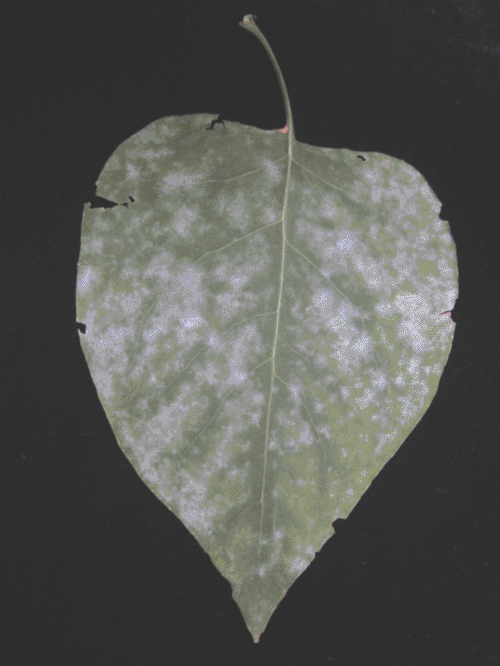S-type powdery mildew on lilac in Australia
J. H. Cunnington A B and R. W. Brett AA Biosciences Research Division, Department of Primary Industries, Knoxfield, Private Bag 15, Ferntree Gully Delivery Centre, Victoria 3156, Australia.
B Corresponding author. Email: james.cunnington@dpi.vic.gov.au
Australasian Plant Disease Notes 4(1) 21-22 https://doi.org/10.1071/DN09009
Submitted: 2 December 2008 Accepted: 28 February 2009 Published: 16 March 2009
Abstract
In 2004, powdery mildew on lilac (Syringa vulgaris) was collected in a home garden in an inner suburb of Melbourne. At that time it could not be identified, but appeared to be the only verifiable record of powdery mildew on lilac in Australia. A recombinant DNA internal transcribed spacer sequence from a 2008 sample, collected from the same garden, revealed that the fungus is the S-type lilac powdery mildew that lacks a clear name.
Powdery mildew occurs on lilac (Syringa spp.) in many parts of the world. Braun (1987) recognised two species of powdery mildew fungi; Erysiphe syringae Schwein. (≡ Microsphaera syringae (Schwein.) H. Magn.) and E. syringae-japonicae U. Braun & S. Takam. (≡ Microsphaera syringae-japonicae U. Braun). The former occurs in Europe and North America. The latter occurs in Asia. The main morphological difference between the two species is that E. syringae forms four or fives ascospores per ascus, while E. syringae-japonica forms 6–8 spores per ascus. However, Bolay (2005) could not find this difference in ascospore numbers and concluded that they were both the same species. A molecular phylogenetic study was undertaken by Seko et al. (2008) to clarify the status of the two species. Seko et al. (2008) demonstrated that two species were present, but could not assign names to them, instead calling them K-type and S-type. Interestingly, the S-type appeared to have been present for a long time in Europe and North America, while the K-type originated in Asia. The K-type then spread to Europe in the early 1990s and out-competed the S-type to become the dominant species.
In December 2004, powdery mildew on lilac (Syringa vulgaris) was collected in a home garden in an inner Melbourne suburb. The shrub was very heavily infected (Fig. 1). Microscopic examination of the fungus revealed that it was a typical Pseudoidium-type anamorphic powdery mildew. Basic morphological characters agreed with those of both E. syringae and E. syringae-japonica (Braun 1987). Conidia were formed singly, ovoid-to-ellipsoid, ~25–30 × 10–15 µm, without fibrosin bodies. Appressoria were multilobed. At that time no further identification was possible. Material was collected from the same garden in April 2008. On this occasion it was decided to obtain a ribosomal DNA internal transcribed spacer (rDNA ITS) sequence to compare with the sequences of the S-type and K-type lilac powdery mildews published by Seko et al. (2008). Both specimens have been deposited in the Department of Primary Industries Victoria Plant Pathology Herbarium (VPRI 32130 and 41368).

|
Total DNA was extracted from leaf material of specimen VPRI 41368 using a DNeasy™ Plant Mini Kit (Qiagen, Melbourne, Australia). The rDNA ITS region was amplified using primers PMITS1 and PMITS2 (Cunnington et al. 2003). The polymerase chain reaction products were sequenced directly using primers ITS5 and ITS4 (White et al. 1990). A similarity search of GenBank sequences revealed the sequence to be identical to AB295460 (Seko et al. 2008) the S-type lilac powdery mildew. The sequence obtained here has been deposited in GenBank as accession FJ755790.
Powdery mildew on lilac in Australia has been recorded under the name Microsphaera alni (Chambers 1982), but this reference does not provide any details on its occurrence, stating only that it is a ‘pre-1940’ report. No specimens of powdery mildew on lilac could be found in any Australian plant pathology herbaria, and the disease is not listed in any other state agriculture department checklists (Simmonds 1966; Sampson and Walker 1982; Cook and Dubé 1989; Shivas 1989). Braun (1987) lists E. syringae in Australia, but this is based on Amano (1986) (U. Braun, 2008 pers. comm.) which was written from an extensive worldwide literature review. The source of this record is unclear as Amano (1986) does not reference Chambers (1982). But Amano (1986) does cite a personal communication from T.H. Harrison in 1961 on powdery mildews in Australia, although this is not directly linked to the powdery mildew on lilac. Amano (1986) also references Harrison et al. (1975) but this publication does not mention diseases of lilac.
We do not know if this is a new introduction into Australia given the rarity of the fungus. Given that the pre-1940 report (Chambers 1982) cannot be confirmed, it is likely that we will never know. Since lilac is commonly grown in Australia and the powdery mildew symptoms are so striking, it seems unlikely that lilac powdery mildew would have remained undetected since the 1940s. If it is a recent arrival, it is interesting that it is the old European S-type, not the more aggressive Asian K-type.
Bolay A
(2005) Les oïdiums de Suisse (Erysiphaceae). Cryptogamica Helvetica 20, 1–173.

Braun U
(1987) A monograph of the Erysiphales (powdery mildews). Beiheft zur Nova Hedwigia 89, 1–700.

Cunnington JH,
Takamatsu S,
Lawrie AC, Pascoe IG
(2003) Molecular identification of anamorphic powdery mildew fungi. Australasian Plant Pathology 32, 421–428.
| Crossref | GoogleScholarGoogle Scholar |
CAS |

Seko Y,
Bolay A,
Kiss L,
Heluta V,
Grigaliunaite B, Takamatsu S
(2008) Molecular evidence is support of recent migration of a powdery mildew fungus on Syringa spp. into Europe from East Asia. Plant Pathology 57, 243–250.
| Crossref | GoogleScholarGoogle Scholar |
CAS |

Shivas RG
(1989) Fungal and bacterial diseases of plants in Western Australia. Journal of the Royal Society of Western Australia 72, 1–62.



